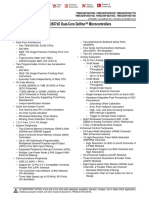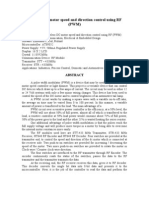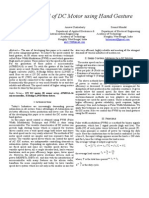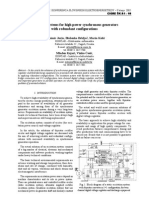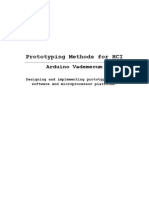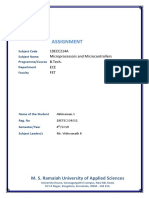Arduino Based Sensorless Speed Control of BLDC Motor Using GSM
Uploaded by
Raja Ramesh DArduino Based Sensorless Speed Control of BLDC Motor Using GSM
Uploaded by
Raja Ramesh D2015 INTERNATIONAL CONFERENCE ON COMPUTATION OF POWER, ENERGY, INFORMATION AND COMMUNICATION
Arduino Based Sensorless Speed Control of
BLDC Motor Using GSM
First A. C.Madhumita, Second B. S.Madhunisha, Third C. S. Madhanagopal, Forth D. A. Manish and
Fifth E. C. Umayal
AbstractThis paper presents design and digital
implementation of an Arduino based controller to improve the
performance of a Brushless DC (BLDC) drive. Simulation of
Sensorless speed control of BLDC motor via Arduino, which is an
open source electronics platform, is presented. Arduino is based
on easy to use hardware and software components which can
receive inputs from many sensors and is capable of controlling
various parameters of a drive. Since application of BLDC motors
range from instrumentation systems, electric vehicles , robotics,
aerospace to space vehicles, the performance of fuzzy and PID
controller based BLDC drives have been under investigation in
recent times. To achieve a simpler and satisfactory transient and
steady state responses an Arduino based speed control is
proposed. In this method, a reference speed is decided where if
the motor speed exceeds the set value of speed, an error message
is sent to the registered mobile device through the global system
for mobile communication (GSM) and the speed control is
performed by the Arduino, thereby controlling the of the motor.
Index Terms BLDC Motor, Sensorless, Arduino, GSM ,
speed control
I. INTRODUCTION
C motors are the most preferred motors in most low and
medium power equipments like fans, air conditioners and
many more applications in the field of medicine and industry
since it has good controllability, have more power to volume
ratio. However it has limited life and leads to maintenance
cost due to the presence of brush. Since efficiency, simplicity
and cost factor are the major concerns is such applications,
BLDC motor has become more popular, due to the following
features. High efficiency, high flux density per unit volume,
low noise, low maintenance and low electromagnetic
inference (EMI) problems[1].
In conventional DC motors with brushes, stator has field
magnets and rotor has armature winding. The motor is
expensive and requires maintenance due to the brushes and
accumulation of brush debris, wear and tear of commutator
and sparking. The brushless DC (BLDC) motor could
This paragraph of the first footnote will contain the date on which you
submitted your paper for review. It will also contain support information,
including sponsor and financial support acknowledgment. For example, This
work was supported in part by the U.S. Department of Commerce under Grant
BS123456.
F. E. C. Umayal is currently working as Assistant Professor in the
Department of EEE, Easwari Engineering College, Chennai, India. (Email:
cumayal@yahoo.com). She is the corresponding author.
overcome these issues by replacing the mechanical switching
components using electronic semiconductor switches.
BLDC motor is a three-phase synchronous motor consisting
of a stator having a three-phase concentrated windings and a
rotor with permanent magnets. Maintenance of the machine
and issues due to sparking of brush are eliminated due to the
absence of mechanical brushes and commutator assembly [24]. BLDC motors are termed as electronically commutated
motor since the commutation is based on Hall Effect Sensors
which provide rotor position signals. Due to these features, the
BLDC motor has become a very popular and viable product in
the market. In fact, the BLDC motor has more advantages
compared with other types of AC motors in the market.
Various types of controllers are available for
BLDC motor drives. Conventional controllers like P, PI and
PID were used with BLDC drives until recent times. To design
these controllers, exact mathematical model of the system or
response of the system should be known. This process is very
tedious for most practical systems which are nonlinear. Since
these systems are approximated as linear systems, the
responses of such systems are not fully dependable. A fuzzy
controller was designed to achieve improved performance of a
BLDC servomotor drive. The performance of the drive is
compared with PID controller based BLDC drive to show that
fuzzy controller based BLDC servomotor drive provides an
improve speed response. It also provides a consistent rise time
and settling time when the drive system is subjected to load
disturbance and parameter variations [5]. Speed of a BLDC
drive can be controlled by controlling dc link voltage of the
voltage source inverter. This reduces switching losses. The
bridgeless buck-boost converter was proposed to offer the
elimination of diode bridge rectifier thereby reducing
conduction losses [6].
Based on the line-to-line back-EMF a sensorless speed
control method was proposed [7]. The line-to-line voltages are
obtained by low pass filters to get commutation signals. Since
these signals are delayed due to low pass filters, the
acceleration is limited. This literature introduces a novel
sensorless commutation algorithm based on the hysteresis
transition. The integration difference between adjacent 60
electrical degrees interval between commutation points is used
as the feedback for PI controllers to compensate errors
automatically.
Either PWM or pulse-amplitude modulation (PAM) can be
used to drive a BLDC motor. Since none of them is suitable
978-1-4673-6524-6/15/$ 31.00 2015 IEEE
C.MADHUMITA et.al: ARDUINO BASED SENSORLESS SPEED CONTROL OF BLDC MOTOR USING GSM
for high-speed BLDC motor in the wide speed range, a hybrid
drive method combining both was introduced. A new
sensorless method based on the virtual neutral voltage for high
speed BLDC motor to suit this hybrid drive method was
proposed [8] which use a low pass filter with super low cutoff
frequency. A novel method for position sensorless control of
BLDC motors with low inductance and non ideal back EMF
was proposed in order to have improved reliability [9]. To
compensate for parametric and dynamic uncertainties in a
BLDC drive a robust adaptive and optimal control scheme is
discussed in [10]. Design of BLDC motor drive controller for
electric vehicle is discussed in [11]. Various control
techniques for BLDC motor drive is discussed in [12-16],
which range from low cost techniques to fuzzy technique.
In the literature surveyed several simulation models are
available for BLDC motor control. However, there is no
comprehensive model for the analysis of motor with Arduino
based control. The work presented in this paper is to obtain
speed control of a BLDC motor using simpler and cost
effective technology. This proposed system is a cost effective
way to control the speed of the BLDC motor since it uses
Arduino, which is an open source environment, to send the
control signals to control speed and furthermore it also
employs a wireless control by using GSM technology.
II. MODELING OF BLDC MOTORS
The BLDC motor drive supplied by an inverter is modeled
[17-18] based on the assumptions that all the stator phase
windings have equal resistance per phase, constant
inductances, ideal semiconductor devices, negligible iron
losses and unsaturated motor. The equivalent circuit of the
BLDC motor drive system is shown in Fig. 1. Equation (1)
gives the voltage equations of the BLDC motor.
Rs
Rs
0
Vab Rs
V 0
bc
Vca Rs
Ls M
0
M Ls
M Ls
Ls M
0
0
Rs
Rs
(1)
0
M Ls
Ls M
ia ea eb
di
ib eb ec
dt
ic ec ea
Mutual inductance is negligible as compared to self
inductance. Ls and M are self and mutual inductance per phase
Equation (1) can be written as
Vab Rs
V 0
bc
Vca Rs
Rs
Rs
0
0 ia
Rs ib
Rs ic
(2)
Ls
0
Ls
Ls
Ls
0
0
Ls
Ls
ia ea eb
di
ib eb ec
dt
ic ec ea
Rs is the stator winding resistance per phase; ea, eb, ec are
back EMFs of the three phases while ia, ib, ic are the phase
currents of three phases.
Electromagnetic torque Te is expressed as
Te (ea ia ebib ec ic ) / K t I
(3)
Here ia=ib=ic=I, is the angular velocity in radians per
second, Kt is the torque constant.
Since Te is utilized to overcome opposing torques of inertia
and load, it is written as
(4)
T T J d / dt B
e
Fig. 1.
Equivalent Circuit of BLDC Drive System.
TL is the load torque and JM is the inertia, BM is the
friction constant of the BLDC motor. TL can also be
expressed in terms of load inertia JL and friction constant BL
as
(5)
d
TL J L
dt
BL
The power developed by the motor is given by
P Te
978-1-4673-6524-6/15/$ 31.00 2015 IEEE
(6)
2015 INTERNATIONAL CONFERENCE ON COMPUTATION OF POWER, ENERGY, INFORMATION AND COMMUNICATION
E ea eb ec K b
Here Kb is the back EMF constant, E is the back EMF per
phase, and is the angular velocity in radians per second. To
design conventional controllers, parameters of both motor and
load are to be determined. The specification of the BLDC
motor used in the proposed Arduino controlled system is 5V
with a power rating of 1W and the rated speed of 3000 RPM.
III. ARDUINO AND PIC MICROCONTROLLER
The proposed speed control of BLDC drive uses
inexpensive Arduino boards and PIC 18F45K22
microcontroller. Arduino is a microcontroller board and open
source environment. This allows the user to make computers
that drive both functional and creative projects. Using Arduino
the user can design and manufacture kits for building digital
devices and interactive objects which can sense and control a
physical parameter. Arduino projects are based on a family of
microcontroller board designs manufactured by many vendors.
This uses various 8-bit Atmel AVR or 32-bit Atmel ARM
processors. These systems provide sets of digital and analog
I/O pins that can be interfaced to various extension boards and
also other circuits. These boards feature serial
communications interfaces, including USB for loading
programs from a personal computer. An integrated
development environment (IDE) is provided by the Arduino
platform for programming the microcontrollers. This also
includes support for C and C++ programming languages.
Arduino boards are inexpensive for projects involving robots
and motion detection [19].
An Arduino board comprises of an Atmel 8-bit AVR
microcontroller along with complementary components that
facilitate programming and incorporation into other circuits.
has simple and clear programming environments. It is an open
source and extensible software and hardware. Certain features
of the Arduino pro mini ATmega 168 and PIC 18F45K22 are
as follows
A. Features of Arduino Pro Mini
Arduino is an open source platform based on a simple
microcontroller board and a development environment to write
software for the board. These boards can be used to develop
interactive objects. The boards can be assembled personally or
bought preassembled. The open source IDE is available free
on net. The Arduino programming language is an
implementation of wiring. Arduino pro Miniis a simple
microcontroller board which is based on the ATmega168. It
has 14 digital I/O pins. This can be powered with either FTDI
cable or breakout board which are connected to its six pin
header or with a regulated supply on the Vcc pin. It has 16kB
flash memory for storing code and 1 KB of SRAM and 512
bytes of EEPROM.Out of the 14 digital I/O pins, a few has
specialized functions like Receiving and Transmitting,
External Interrupts, LED, PWM etc.,. There is also a RESET
pin on-board [19].
B. Features of PIC 18F45K22
Though Arduino has an UART, it cannot perform two
bidirectional operations. Hence a PIC is used as a bridge to
provide the bidirectional communication and it is completely
interfaced with the Arduino. In the proposed system, PIC
18F45K22 is used for this purpose, whose features are listed
below.
Full 5.5V operation
Low voltage option available
Programmable code protection
In-Circuit Debug via two pins [20].
IV. PROPOSED SYSTEM
Fig. 3 shows the general block diagram of the proposed
system
Fig. 2.
Arduino Board
One of the important feature of Arduino is its connectors
allow the user connect the CPU board to a various
interchangeable add-on modules called shields. Some shields
communicate with the board directly through various pins.
Most of the features make Arduino boards usable by any
ordinary computer. The board exposes most of the I/O pins of
the microcontroller to be used by other circuits.
The proposed project uses Arduino pro mini ATmega 168,
since it is inexpensive, it can function across any platform, and
Fig. 3.
Block Diagram of the proposed system
A single phase supply is used to supply a rectifier. The
BLDC motor drive is fed by a three phase voltage source
inverter. To control the speed of the motor, the modulation
index of the converter feeding the BLDC drive is controlled
by varying the duty ratio of the PWM pulses. To reduce
switching losses the inverter is operated at a low switching
978-1-4673-6524-6/15/$ 31.00 2015 IEEE
C.MADHUMITA et.al: ARDUINO BASED SENSORLESS SPEED CONTROL OF BLDC MOTOR USING GSM
Time Series Plot:
2000
1500
1000
Voltage(V)
frequency.
Initially the reference speed is given by either GSM under
automatic control or by PC under manual control. After a
cycle of operation, under no load condition, the actual speed
of the motor is obtained from the rotor position sensed by the
Hall Effect Sensors. This speed dc is compared with the
reference speed ref thereby generating the error speed e. If
the speed exceeds the reference speed an error message is
generated. Once an error is detected an error message is sent
by the Arduino to the registered mobile via GSM which in
turn sends the control message to the Arduino board. On
receiving this message, the speed error is received by the
Arduino board which generates PWM signal to be given to the
inverter, thereby controlling the speed of the motor.
Fig. 4 shows the simulated block diagram of the proposed
system and Fig. 5 shows the three phase inverter. Fig. 6 shows
the input voltage waveform of the BLDC drive with respect to
time.
500
0
-500
-1000
-1500
-2000
Fig. 6.
0.05
0.1
0.15
Time (seconds)
0.2
0.25
Waveform of Input Voltage
V. SIMULATION RESULTS
Fig. 7 shows the variation of three phase current with
respect to time. Under constant loads currents will be in phase
with each other and the waveform will be constant without
any deviation. is the angle of rotation of the BLDC drive.
Fig. 8 shows the variation of with time.
Current Time Plot
100
80
60
current(amperes)
40
20
0
-20
-40
-60
-80
-100
0.12
0.14
0.16
0.18
0.2
0.22
Time (seconds)
Fig. 7.
Waveform of three phase current
Theta Time Plot
1000
900
Fig. 4.
General Simulation Block Diagram
800
700
Theta
600
500
400
300
200
100
0
0.1
0.2
0.3
0.4
0.5
0.6
0.7
0.8
0.9
Time (seconds)
Fig. 8.
Fig. 5.
Three phase inverter
Waveform of Theta Vs Time during general and error condition
By measuring the value of theta , back EMF can be
obtained.
q
(7)
e
B j rj l
j 1
Where e/ is the back-EMF constant , is the rotational
angle of the rotor , l is the conductor length, is the angular
velocity, magnetic flux density is B, r is the radius of the
conductor. Back EMF constant is the back-EMF per unit
978-1-4673-6524-6/15/$ 31.00 2015 IEEE
2015 INTERNATIONAL CONFERENCE ON COMPUTATION OF POWER, ENERGY, INFORMATION AND COMMUNICATION
rotational speed. Fig. 9 shows the variation of back EMF with
respect to time.
Emf Time Plot
150
100
In the GSM modem is used for setting the reference speed,
sending the error message and for receiving the control
message. An Arduino is used for sending the control signals to
make the motor run at the set speed and a PIC controller is
used to provide a bidirectional communication.
EMF(V)
50
-50
-100
-150
Fig. 9.
0.055
0.06
0.065
Time (seconds)
0.07
0.075
Waveform of EMF Vs Time during general and error condition
Fig. 10 shows the waveform of speed vs time before and
after the reference speed is changed from 2000 RPM to 2500
RPM.
Speed Time Plot
3000
2500
Fig. 12. Hardware showing the interface between PIC and GSM modem.
Speed(rpm)
2000
1500
1000
500
0.1
0.2
0.3
0.4
0.5
Time (seconds)
0.6
0.7
0.8
0.9
Fig. 10. Waveform of Speed Vs Time before and after the reference speed is
changed from 2000 RPM to 2500 RPM.
The above results show that initially under constant loads,
the motor starts running at the given reference speed of 2000
RPM. After 0.5 seconds, the reference speed is changed to
2500 RPM. The waveform shown in Fig. 10 depicts this
variation in speed from 2000 RPM to 2500 RPM. Also an
error is manually created at 0.2 seconds which is found as a
dip in the waveform at 0.2 seconds. Thereby it is shown that in
the proposed system the speed of the motor is controlled by
changing the reference speed. It can also be seen, when there
is no error, the speed of the motor is constant at the set speed.
VI. EXPERIMENTAL RESULTS
Fig. 13. Waveform when an error occurs.
When the speed of the motor exceeds the reference speed,
an error occurs which is indicated by the dip in the waveform.
Once this error is detected an error message is sent to the
mobile through the GSM modem.
The experimental setup is shown in Fig. 11.
Fig. 14. Waveform depicting steady speed at 2000 RPM
Fig. 11. Experimental Setup
978-1-4673-6524-6/15/$ 31.00 2015 IEEE
C.MADHUMITA et.al: ARDUINO BASED SENSORLESS SPEED CONTROL OF BLDC MOTOR USING GSM
After receiving the control message from GSM the Arduino
will generate the control signals to run the motor at steady
speed. The straight line shown in Fig. 14 depicts that the
motor is running at steady speed as set by the reference speed.
VII. CONCLUSIONS
Machines and their Control. Boca Raton, FL: CRC Press, 2009, pp. 451563.
[18] P. Pillay and R. Krishnan, Modeling, Simulation, and Analysis of
Permanent-Magnet Motor Drives, part II The brushless dc motor drive,
IEEE Trans. Ind.Appl, vol. 25, no. 2, pp.274-279, Mar/Apr. 1989.
[19] www. http://arduino.cc/
[20] http://www.microchip.com
The proposed technique depicts the Sensorless control of
BLDC motor using Arduino which is more effective than the
usual control techniques. Moreover, the use of GSM is an
added advantage to this technique where control is possible
even when the operator is not present. This technique finds its
application in various equipments like fans, pumps and
compressor drives where constant speed is required.
REFERENCES
[1]
[2]
[3]
[4]
[5]
[6]
[7]
[8]
[9]
[10]
[11]
[12]
[13]
[14]
[15]
[16]
[17]
First A. C. Madhumita is currently in her
final semester of her under graduate
course in the field of Electrical and
Electronics Engineering at Easwari
Engineering College, Ramapuram in
Chennai, India. She is a member of
Rotaract and ISTE clubs. Her hobby is
playing Veena. Electrical Machines are her
field of interest.
C. L. Xia, Permanent Magnet Brushless DC Motor Drives and
Controls, Hoboken, NJ, USA : Wiley, 2012
J.R.Handershot and T.J.E Miller, Designof Brushless Permanent
Magnet Motors, Oxford, U.K.: Clarendon Press, 2010.
T. Kenjo and S. Nagamori, Permanent Magnet Brushless DC Motors,
Clarendon Press, Oxford, 1985.
H.A. Toliyat and S. Campbell, DSP-Base Eletromechanical Motion
Control, New York, NY, USA: CRC Press, 2004.
R. Shanmugasundram, K. Muhammad Zakariah, and N. Yadaiah,
Implementation and Performance Analysis of Digital Controllers for
Brushless DC Motor Drives, IEEE Trans. Mechatronics., vol. 19.no.1,
pp. 871-887, Feb. 2014.
B. Vashist and Bhim Singh, An Adjustable-speed PFC Bridgeless
Buck-Boost Converter fed BLDC Motor Drive, IEEE Trans. Ind.Elect.,
vol. 61. no. 6, pp.2665-2677, June. 2014.
L. Gang, C. Chenjun, W. Kun, and H. Bangcheng, Sensorless Control
for High-Speed Brushless DC Motor Based on the Line-to-Line BackEMF, IEEE Trans. Power Elec, Unpublished.
C. Chenjun, L. Gang, W. Kun, and S. Xinda, Sensorless Drive for
high-speed Brushless DC motor based on the virtual neutral voltage,
IEEE Trans. Power Elec., vol. 30. no. 6, pp. 3275-3285, June . 2015.
L. Wenzhuo, F. Jiancheng, H. Li, and J. Tang, Position Sensorless
Control without phase shifter for high-speed BLDC motors wth low
inductance and nonideal back EMF, IEEE. Trans on Power Elec.,
Unpublished.
A. Rubaai, D. Ricketts, and M.D. Kankam, Development and
implementation of an adaptive fuzzy-neural-network controller for
brushes drives, IEEE Trans. Ind. Appl., vol.38, no.2, pp. 441-447.
Mar-Apr.2012.
F. Rodriguez and A. Emadi, A novel digital control technique for
brushless DC motor drives , IEEE Trans. Ind. Elec., vol. 54, no.5,
pp.2365-2375. Oct. 2007.
R. Shanmugasundara, K.M. Zakariah, and N. Yadaiah, Low-cost high
performance brushless DC motor drive for speed control applications,
in ARTCom 09, Proc. IEEE Int. Conf. Adv. Recent Tech. Commun.
Comput., Kotayam, India, Oct. 27-28, 2009, pp. 456-460.
R. Shanmugasundara, K.M. Zakariah, and N. Yadaiah, Digital
Implementation of fuzzy logic controller for wide range speed control of
brushless DC motor, in Proc. IEEE Int. Conf. Veh. Electron. Safety,
Pune, India, Nov. 10-12, 2009, pp. 119-124.
H.-x.Wu, S.-k. Cheng, and S.-m. Cui, A controller of brushless DC
motor for electric vehicle, IEEE Trans. Magn.., vol. 41. no. 1, pp. 509513, Jan .2005.
R. Shanmugasundara, K.M. Zakariah, and N. Yadaiah, Modelling,
simulation and analysis of controllers for brushless DC motor drives,
J.vib.
control
[online].
pp.
1-15.
Available:
http://jvc.sagepub.com/content/early/2012/05/11/1077546312445200
S.B. Ozturk and H.A. Toliyat, Direct Torque and indirect flux control
of brushless DC motor, IEEE/ASME Trans. Mechatronics., vol. 16,
no.2, pp. 351-360, Apr. 2011.
R. Krishnan, Permanent Magnet Synchronous and Brushless DC Motor
Drives: Theory, Operation, Performance, Modeling, Simulation,
Analysis, and Design- Part 3, in Permanent Magnet Brushless DC
Second B. S. Madhunisha is currently in
the final semester of her under graduate
course in the field of Electrical and
Electronics Engineering at Easwari
Engineering College, Ramapuram in
Chennai. She is a member of Rotaract and
ISTE clubs. Her hobby is classical dancing.
.Electrical machines are her field of
interest.
Third C. S. Madhanagopal is currently
in the final semeester of his under
graduate course in the field of Electrical
and Electronics Engineering at Easwari
Engineering College, Ramapuram in
Chennai. His hobby is acting and has
won prizes in many cultural fests.
Fourth D. A. Manish is currently in the
final semester of his under graduate
course in the field of Electrical and
Electronics Engineering at Easwari
Engineering College, Ramapuram in
Chennai. His hobbies are playing basket
ball and table tennis. He is also a state
level player in basket ball.
Fifth E. C. Umayal has obtained her
M.E Degree in Power Electronics and
Drives from Anna University, Chennai,
India in the year 2005, and Ph.D in
Electrical Engineering from Anna
University in the year 2014. She has 14
years of teaching experience and 8
years of industrial experience. She is a
member of IET. She is currently
working in Easwari Engineering College, Chennai as Assistant
Professor in the Department of EEE. Her research interests
include Renewable Energy Sources and PMBLDC drives. She
has published papers in the area of Power Electronics and
PMBLDC motors.
978-1-4673-6524-6/15/$ 31.00 2015 IEEE
You might also like
- Tabletop CNC Wire Bender Machine Using DXF by Generating CNC CodesNo ratings yetTabletop CNC Wire Bender Machine Using DXF by Generating CNC Codes4 pages
- Mach3 USB Motion Card (SW43B) Installation ManualNo ratings yetMach3 USB Motion Card (SW43B) Installation Manual35 pages
- Control BLDC Motor Speed Using PID ControllerNo ratings yetControl BLDC Motor Speed Using PID Controller5 pages
- Simulation of Some Power System, Control System and Power Electronics Case Studies Using Matlab and PowerWorld SimulatorFrom EverandSimulation of Some Power System, Control System and Power Electronics Case Studies Using Matlab and PowerWorld SimulatorNo ratings yet
- Speed Control of Induction Motor by Using IR11No ratings yetSpeed Control of Induction Motor by Using IR1116 pages
- GSM Mobile Based Speed Control of DC MotorNo ratings yetGSM Mobile Based Speed Control of DC Motor10 pages
- Wireless DC Motor Speed and Direction Control Using RFNo ratings yetWireless DC Motor Speed and Direction Control Using RF3 pages
- How To Mechatronics Tutorials - Arduino DC Motor Control L298N PWM H BridgeNo ratings yetHow To Mechatronics Tutorials - Arduino DC Motor Control L298N PWM H Bridge51 pages
- Speed Control of DC Motor Using PWM Technique83% (6)Speed Control of DC Motor Using PWM Technique42 pages
- Project Report On Speed Control of DC Motor by Using PWM TechniqueNo ratings yetProject Report On Speed Control of DC Motor by Using PWM Technique76 pages
- A Vector Control System of PMSM With The Assistance of Fuzzy PID ControllerNo ratings yetA Vector Control System of PMSM With The Assistance of Fuzzy PID Controller6 pages
- MICROCONTROLLER-based DC Motor Speed Controller100% (1)MICROCONTROLLER-based DC Motor Speed Controller8 pages
- Automatic Engine Locking System Through Alcohol Detection For Drunken DriversNo ratings yetAutomatic Engine Locking System Through Alcohol Detection For Drunken Drivers44 pages
- DC Motor Speed Control With PIC Microcontroller100% (1)DC Motor Speed Control With PIC Microcontroller4 pages
- Objectives: Experiment No. 2 Driving Stepper MotorNo ratings yetObjectives: Experiment No. 2 Driving Stepper Motor6 pages
- DTMF Based DC Motor Speed and Direction ControlNo ratings yetDTMF Based DC Motor Speed and Direction Control4 pages
- Design and Construction of Tachometer Using Arduino MicrocontrollerNo ratings yetDesign and Construction of Tachometer Using Arduino Microcontroller18 pages
- Stepper Motor Positioning Control by IR RemoteNo ratings yetStepper Motor Positioning Control by IR Remote80 pages
- Speed Control of A DC Motor Using Hand GestureNo ratings yetSpeed Control of A DC Motor Using Hand Gesture4 pages
- Speed Control of PMSM Using HALL Signal Effect With Six Pulse Inverter in MATLAB/SIMLINKNo ratings yetSpeed Control of PMSM Using HALL Signal Effect With Six Pulse Inverter in MATLAB/SIMLINK8 pages
- Torque of ThreePhase Induction Motor ExplainedNo ratings yetTorque of ThreePhase Induction Motor Explained2 pages
- Automatic Escalator Control System Using PLC Ijariie1975100% (1)Automatic Escalator Control System Using PLC Ijariie19755 pages
- Design and Prototyping of Micro Mobility Electric VehicleNo ratings yetDesign and Prototyping of Micro Mobility Electric Vehicle5 pages
- DC Motor Speed Controller Design Using Pulse WidthNo ratings yetDC Motor Speed Controller Design Using Pulse Width12 pages
- Speed and Position Control of DC Motor Using LabVIEW-IJRASETNo ratings yetSpeed and Position Control of DC Motor Using LabVIEW-IJRASET8 pages
- A Modified Sepic Converter For High-Power-FactorNo ratings yetA Modified Sepic Converter For High-Power-Factor23 pages
- A Project Report ON: Speed Control of DC Motor Using GSM ModuleNo ratings yetA Project Report ON: Speed Control of DC Motor Using GSM Module71 pages
- Bi Directional Rotation of Single Phase Induction Motor Without Run CapacitorNo ratings yetBi Directional Rotation of Single Phase Induction Motor Without Run Capacitor2 pages
- Car Parking Guard Circuit Using Infrared Sensor100% (4)Car Parking Guard Circuit Using Infrared Sensor5 pages
- Closed Loop Control of Stepper Motor Without Position SensorNo ratings yetClosed Loop Control of Stepper Motor Without Position Sensor9 pages
- How To Drive DC Motors With Smart Power IcsNo ratings yetHow To Drive DC Motors With Smart Power Ics14 pages
- Speed Control of BLDC Motor Using IPM and Micro 2812 Ver.2.0100% (1)Speed Control of BLDC Motor Using IPM and Micro 2812 Ver.2.041 pages
- Low Cost' Three Phase To Single Phase Matrix ConverterNo ratings yetLow Cost' Three Phase To Single Phase Matrix Converter6 pages
- Speed Control of BLDC Motor For Electric PDFNo ratings yetSpeed Control of BLDC Motor For Electric PDF6 pages
- Flex Sensor Based Hand Glove For Deaf and Mute PeopleNo ratings yetFlex Sensor Based Hand Glove For Deaf and Mute People12 pages
- Rfid Based Attendance System: A Project-IINo ratings yetRfid Based Attendance System: A Project-II48 pages
- Attendance Checking System Using Radio-Frequency Identification Device (RFID)No ratings yetAttendance Checking System Using Radio-Frequency Identification Device (RFID)32 pages
- Design of 4-DOF manipulator based on ArduinoNo ratings yetDesign of 4-DOF manipulator based on Arduino4 pages
- Installing and Compiling With WinAVR in WindowsNo ratings yetInstalling and Compiling With WinAVR in Windows13 pages
- GitHub - Leokoppel - GP22 - An Arduino Library For The Acam GP22 Time-to-Digital ConverterNo ratings yetGitHub - Leokoppel - GP22 - An Arduino Library For The Acam GP22 Time-to-Digital Converter2 pages
- Adafruit Ccs811 Air Quality Sensor-1396546No ratings yetAdafruit Ccs811 Air Quality Sensor-139654622 pages
- Sivakumar.k - 217, SSM Polytechnic CollegeNo ratings yetSivakumar.k - 217, SSM Polytechnic College6 pages
- IoT Based Automated Weather Report Generation and Prediction Using Machine Learning-UnlockedNo ratings yetIoT Based Automated Weather Report Generation and Prediction Using Machine Learning-Unlocked6 pages
- Advanced Military Spying and Bomb Disposal Robot: Senthamizh.R1, Subbu Lakshmi.P1, Subhashree.P1, Prof. M.Priyadarshini2No ratings yetAdvanced Military Spying and Bomb Disposal Robot: Senthamizh.R1, Subbu Lakshmi.P1, Subhashree.P1, Prof. M.Priyadarshini23 pages
- Tabletop CNC Wire Bender Machine Using DXF by Generating CNC CodesTabletop CNC Wire Bender Machine Using DXF by Generating CNC Codes
- Simulation of Some Power System, Control System and Power Electronics Case Studies Using Matlab and PowerWorld SimulatorFrom EverandSimulation of Some Power System, Control System and Power Electronics Case Studies Using Matlab and PowerWorld Simulator
- Wireless DC Motor Speed and Direction Control Using RFWireless DC Motor Speed and Direction Control Using RF
- How To Mechatronics Tutorials - Arduino DC Motor Control L298N PWM H BridgeHow To Mechatronics Tutorials - Arduino DC Motor Control L298N PWM H Bridge
- Project Report On Speed Control of DC Motor by Using PWM TechniqueProject Report On Speed Control of DC Motor by Using PWM Technique
- A Vector Control System of PMSM With The Assistance of Fuzzy PID ControllerA Vector Control System of PMSM With The Assistance of Fuzzy PID Controller
- Automatic Engine Locking System Through Alcohol Detection For Drunken DriversAutomatic Engine Locking System Through Alcohol Detection For Drunken Drivers
- Objectives: Experiment No. 2 Driving Stepper MotorObjectives: Experiment No. 2 Driving Stepper Motor
- Design and Construction of Tachometer Using Arduino MicrocontrollerDesign and Construction of Tachometer Using Arduino Microcontroller
- Speed Control of PMSM Using HALL Signal Effect With Six Pulse Inverter in MATLAB/SIMLINKSpeed Control of PMSM Using HALL Signal Effect With Six Pulse Inverter in MATLAB/SIMLINK
- Automatic Escalator Control System Using PLC Ijariie1975Automatic Escalator Control System Using PLC Ijariie1975
- Design and Prototyping of Micro Mobility Electric VehicleDesign and Prototyping of Micro Mobility Electric Vehicle
- DC Motor Speed Controller Design Using Pulse WidthDC Motor Speed Controller Design Using Pulse Width
- Speed and Position Control of DC Motor Using LabVIEW-IJRASETSpeed and Position Control of DC Motor Using LabVIEW-IJRASET
- A Project Report ON: Speed Control of DC Motor Using GSM ModuleA Project Report ON: Speed Control of DC Motor Using GSM Module
- Bi Directional Rotation of Single Phase Induction Motor Without Run CapacitorBi Directional Rotation of Single Phase Induction Motor Without Run Capacitor
- Closed Loop Control of Stepper Motor Without Position SensorClosed Loop Control of Stepper Motor Without Position Sensor
- Speed Control of BLDC Motor Using IPM and Micro 2812 Ver.2.0Speed Control of BLDC Motor Using IPM and Micro 2812 Ver.2.0
- Low Cost' Three Phase To Single Phase Matrix ConverterLow Cost' Three Phase To Single Phase Matrix Converter
- Computer Aided Design of Electrical MachinesFrom EverandComputer Aided Design of Electrical Machines
- Flex Sensor Based Hand Glove For Deaf and Mute PeopleFlex Sensor Based Hand Glove For Deaf and Mute People
- Attendance Checking System Using Radio-Frequency Identification Device (RFID)Attendance Checking System Using Radio-Frequency Identification Device (RFID)
- GitHub - Leokoppel - GP22 - An Arduino Library For The Acam GP22 Time-to-Digital ConverterGitHub - Leokoppel - GP22 - An Arduino Library For The Acam GP22 Time-to-Digital Converter
- IoT Based Automated Weather Report Generation and Prediction Using Machine Learning-UnlockedIoT Based Automated Weather Report Generation and Prediction Using Machine Learning-Unlocked
- Advanced Military Spying and Bomb Disposal Robot: Senthamizh.R1, Subbu Lakshmi.P1, Subhashree.P1, Prof. M.Priyadarshini2Advanced Military Spying and Bomb Disposal Robot: Senthamizh.R1, Subbu Lakshmi.P1, Subhashree.P1, Prof. M.Priyadarshini2







